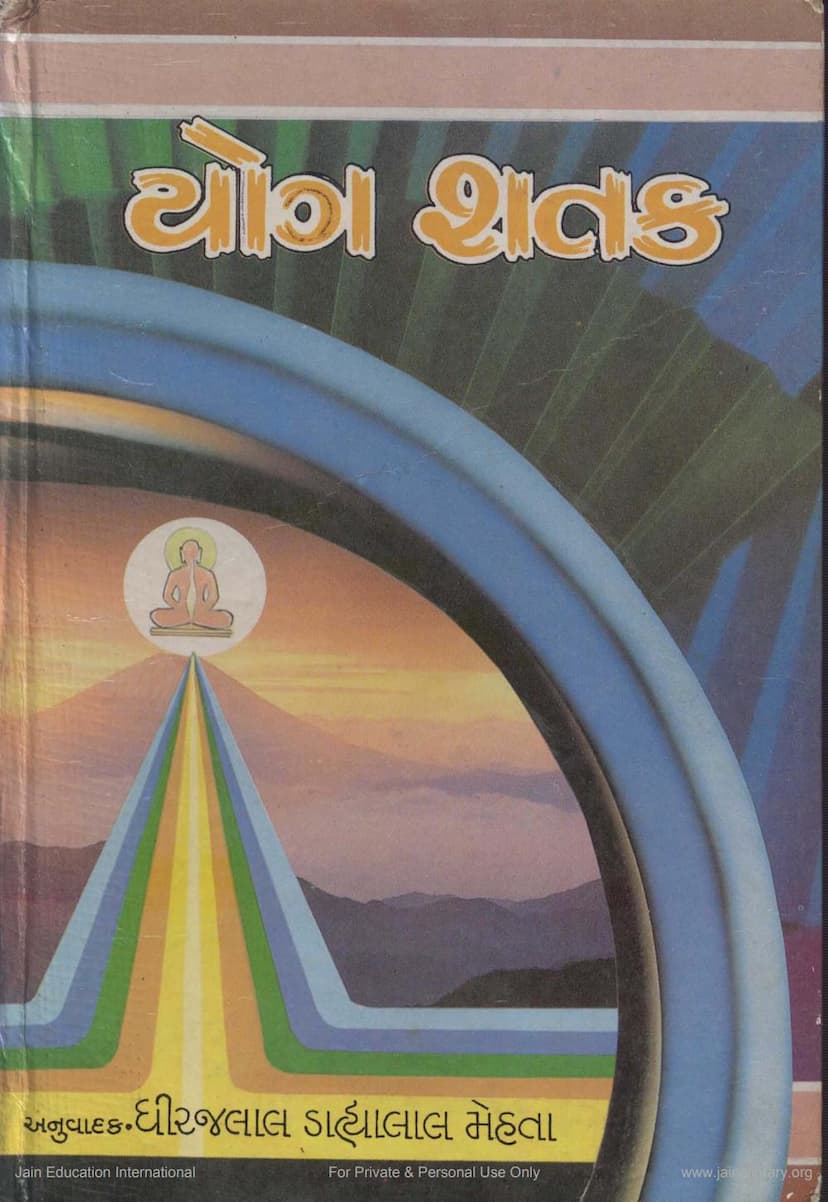Yogashatak
Added to library: September 2, 2025

Summary
Here's a comprehensive summary of the Jain text "Yogashatak" by Haribhadrasuri, based on the provided pages:
Title: Yogashatak (योगशतक) Author: Acharya Shri Haribhadrasuri (आचार्य श्री हरिभद्रसूरीश्वरजी) Commentary: Swopadnya Sanskrit Teeka (स्चोपज्ञ संस्कृत टीका - self-commentary) and its Gujarati translation and commentary. Translator/Commentator: Dhirajlal Dahyalal Mehta (ધીરજલાલ ડાહ્યાલાલ મહેતા) Publisher: Jain Dharm Prasaran Trust, Surat (जैन धर्म प्रसारण ट्रस्ट, सूरत)
Overall Purpose and Context:
The "Yogashatak" is a foundational Jain text focused on the concept of Yoga, presented from a Jain philosophical perspective. The commentary by Dhirajlal Mehta aims to make this complex work accessible to a wider audience through Gujarati translation and detailed explanations. The work emphasizes Yoga as a means to spiritual liberation (Moksha) and spiritual upliftment of the soul.
Key Aspects and Themes:
-
The Nature of Yoga in Jainism:
- Yoga is defined as that which connects the soul (Ātman) to liberation (Moksha). It's a process of the soul's upward journey.
- Haribhadrasuri, a prolific Jain scholar, is noted for his vast literary output, including four major works on Yoga: "Yogavimshati" (in Vinshati Vimshika), "Yogashatak," "Yogadrishti Samuchchay," and "Yogabindu." The work highlights the sequential and comprehensive nature of these texts.
- The text posits that Yoga is not merely physical posture but a deeper spiritual practice aimed at connecting the soul to its true, liberated state.
-
The Author, Haribhadrasuri: * The introduction provides a biographical sketch of Haribhadrasuri, emphasizing his scholarly prowess and dedication to the Jain tradition. * He is described as a luminary in Jain philosophy, a master of dialectics (Tarkasamrat), and a prolific writer (1444 works). * His conversion to Jainism from a Brahmanical background is detailed, highlighting his intellectual journey and eventual deep devotion to Jain principles. The anecdote of his encounter with the learned Sadhvi Yakshini Mahattara, who recited a difficult Prakrit verse, led to his philosophical inquiry and eventual acceptance of Jainism. * His mastery of various subjects and his role in refuting opposing philosophical viewpoints (like Monism) are praised. * The text mentions his lineage and adherence to the teachings of Acharya Jinabhatt, further grounding his work within the Śvetāmbara tradition. * The tragic loss of his disciples and his subsequent dedication to scholarly work as a form of spiritual progeny are mentioned, underscoring his commitment to spiritual propagation through literature. * His passing occurred after observing a fast unto death (Aṇashana).
-
The Text's Structure and Content: * The "Yogashatak" itself is a work of 100 verses (Gathas). * The commentary meticulously breaks down the concepts, explaining the Sanskrit commentary and translating it into Gujarati. * The text delves into various aspects of Yoga, including:
- Definitions of Yoga: Distinguishing between Nishchaya Yoga (Nishchaya Yoga - ultimate reality) and Vyavahara Yoga (Vyavahara Yoga - practical application).
- The Qualified Practitioner: Describing the types of souls qualified for Yoga, categorized into Apunarbandhak (one who does not bind new karma), Aviratasamyag-drashti (one with right faith but not full conduct), Desavirati-dhar (one with partial conduct), and Sarvavirati-dhar (one with full conduct).
- Practices and Principles: Discussing the characteristics of these practitioners, the appropriate teachings for them, the consideration of self-nature, understanding karmic processes, and the contemplation of virtues like Maitri (friendship), Mudita (joy), Karuna (compassion), and Madhyastha (equanimity).
- Comparison with Other Philosophies: Haribhadrasuri's approach is highlighted for its comparative analysis of Yoga as understood in other Indian philosophical schools (like Patanjali and Gopendra) and its integration with Jain principles. He uses respectful terms for other thinkers, demonstrating intellectual magnanimity.
- Ethical Foundations: Emphasizing the avoidance of passions (Raga, Dwesha, Moha) and the cultivation of opposing virtues.
- Anekanatavada: The text implicitly or explicitly establishes the Jain doctrine of manifold aspects (Anekāntavāda) within the discussion of Yoga.
- The Nature of Reality: Discussing the interplay of cause and effect, the impermanence of worldly phenomena, and the soul's eternal nature.
- The Path to Liberation: The text elucidates how Yoga, through right knowledge, right faith, and right conduct, leads to the destruction of karma and ultimately to liberation.
- Specific Practices: The text touches upon concepts like Shuklahara (pure diet), Lābdhis (spiritual powers), Samatābhava (equanimity), understanding death, and the practice of fasting (Aṇashana) as pathways to liberation.
-
Commentary's Approach: * Dhirajlal Mehta expresses gratitude for the inspiration and guidance received from various scholars and monks in preparing the translation and commentary. * The commentary aims for clarity, simplicity, and accessibility for a broad audience, including explanations of difficult Sanskrit terms and segmentation of long paragraphs for better understanding. * It acknowledges the possibility of minor errors due to the limitations of a human author (Chhadmastha) and welcomes corrections for future editions.
-
Importance of the Text: * It is presented as a guide for spiritual upliftment, capable of softening even hardened hearts through its profound philosophical insights. * It promotes detachment from the world (Nirveda) and enthusiasm for liberation (Samvega). * It offers a beautiful comparison and integration of yogic views from different philosophical traditions with Jain philosophy, promoting a non-sectarian appreciation for wisdom. * The commentary itself is praised for making the profound meanings of Haribhadrasuri's original work accessible.
In essence, "Yogashatak" with its Gujarati commentary serves as a vital resource for understanding Yoga within the Jain framework, emphasizing the practical application of spiritual principles for soul purification and ultimate liberation, authored by the highly revered Acharya Haribhadrasuri.